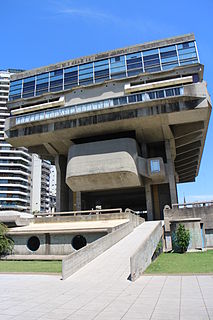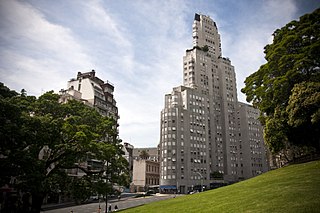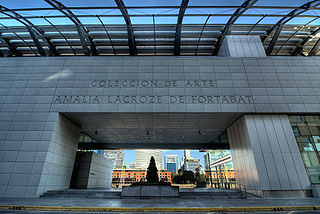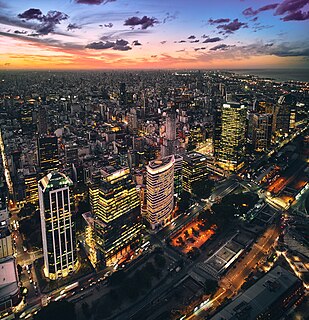
The University of Buenos Aires is a public research university in Buenos Aires, Argentina. Established in 1821, it is the premier institution of higher learning in the country and one of the most prestigious universities of Ibero-America and the world. It has educated 17 Argentine presidents, produced four of the country's five Nobel Prize laureates, and is responsible for approximately 40% of the country's research output. The QS World University Rankings currently places the UBA at number 66 in the world.

The Torcuato Di Tella University is a non-profit private university founded in 1991. Located Buenos Aires, Argentina, it is focused primarily on social sciences.

Recoleta is a barrio or neighborhood of Buenos Aires, Argentina, located in the northern part of the city, by the Río de la Plata. The area is perhaps best known to be the home of the distinguished Recoleta Cemetery. It is a traditional upper-class and conservative neighborhood, with some of the priciest real estate in the city.

The Mariano Moreno National Library is the largest library in Argentina. It is located in the barrio of Recoleta in Buenos Aires. The library is named after Mariano Moreno, one of the ideologists of the May Revolution and its first director.

The Kavanagh Building is a famed skyscraper in Retiro, Buenos Aires, Argentina. Designed in 1934 by architects Gregorio Sánchez, Ernesto Lagos and Luis María de la Torre, it is considered a pinnacle of modernist architecture. At the time of its inauguration in 1936, the Kavanagh was the tallest building in Latin America surpassing the Palacio Salvo built in Montevideo in 1928, as well as the tallest building in the world with a reinforced concrete structure.

The Recoleta Cultural Centre is an exhibition and cultural events centre located in the barrio of Recoleta, Buenos Aires, Argentina. It holds sculptures and exhibitions, as well as concerts and artistic presentations and workshops of diverse types. in September/October 2006 it held the wildly successful onedotzero festival attracting over 20,000 people in 3 days for installations, live performances, screenings and music.

The architecture of Argentina can be said to start at the beginning of the Spanish colonisation, though it was in the 18th century that the cities of the country reached their splendour. Cities like Córdoba, Salta, Mendoza, and also Buenos Aires conserved most their historical Spanish colonial architecture in spite of their urban growth.
The Centro de Arte y Comunicación (CAyC) was an arts organization based in Buenos Aires, Argentina, that was instrumental in creating an international arts movement based on the ideas of systems art within conceptual art.

Clorindo Manuel José Testa was an Italian-Argentine architect and artist.

La Perla Spa is a seaside resort created by the unification of five smaller spas along La Perla beach in Mar del Plata, Argentina. The architectural project was designed by Clorindo Testa, and completed in 1985.

The headquarters of the Banco de Londres y América del Sur or Bank of London and South America in Buenos Aires was designed by Argentine architects Clorindo Testa and SEPRA. It is located in San Nicolás.

Campus Universidad del Salvador is an architectural project created by Clorindo Testa for the Universidad del Salvador in Pilar, Buenos Aires. It comprises an auditorium and a library. The auditorium has capacity for 600 people and was designed not only for academic functions but for other types of cultural uses. It is designed in the shape of a large mound in the manner of an ancient Egyptian tomb.
Casa Capotesta is a house in Pinamar Partido, a coastal resort in the province of Buenos Aires, Argentina. It was designed in 1983 by the architect Clorindo Testa, who was a prominent member of the Argentine rationalist movement and one of the pioneers of brutalist architecture there. He designed the house for himself, as a summer residence. The name of the house is a play on capo, Italian for "head" or "leader", and the surname of the architect.
Casa La Tumbona is a house on the beach in Ostende, a coastal resort in Pinamar Partido in the province of Buenos Aires, Argentina. It was designed in 1986 by the architect Clorindo Testa, who is a prominent member of the Argentine rationalist movement and one of the pioneers of brutalist architecture there and the architects Juan Genoud and Elena Acquarone. The house is elevated on pillars and located so close to the sea that the waves at times can wash underneath the house. This can create an illusion of being aboard a ship, as only water can be seen from the windows facing the sea.
The Bank of London and South America Limited was a British bank, which operated in South America between 1923 and 1971.

The Amalia Lacroze de Fortabat Art Collection is a museum of fine arts in Buenos Aires, Argentina.

The Buenos Aires Central Business District is the main commercial centre of Buenos Aires, Argentina, though not an official city ward. While the barrios of Puerto Madero and Retiro house important business complexes and modern high-rise architecture, the area traditionally known as Microcentro is located within San Nicolás and Monserrat, roughly coinciding with the area around the historic center of the Plaza de Mayo. The Microcentro has a wide concentration of offices, service companies and banks, and a large circulation of pedestrians on working days. Another name given to this unofficial barrio is La City, which refers more precisely to an even smaller sector within the Microcentro, where almost all the banking headquarters of the country are concentrated.

Mario Roberto Álvarez was an Argentine architect.

Alicia Cazzaniga (1928–1968) was an Argentine modernist architect. She is best known for her work in designing the National Library of the Argentine Republic.

The Chamber of Deputies of La Pampa Province is the unicameral legislative body of La Pampa Province, in Argentina. It convenes in the provincial capital, Santa Rosa.

















